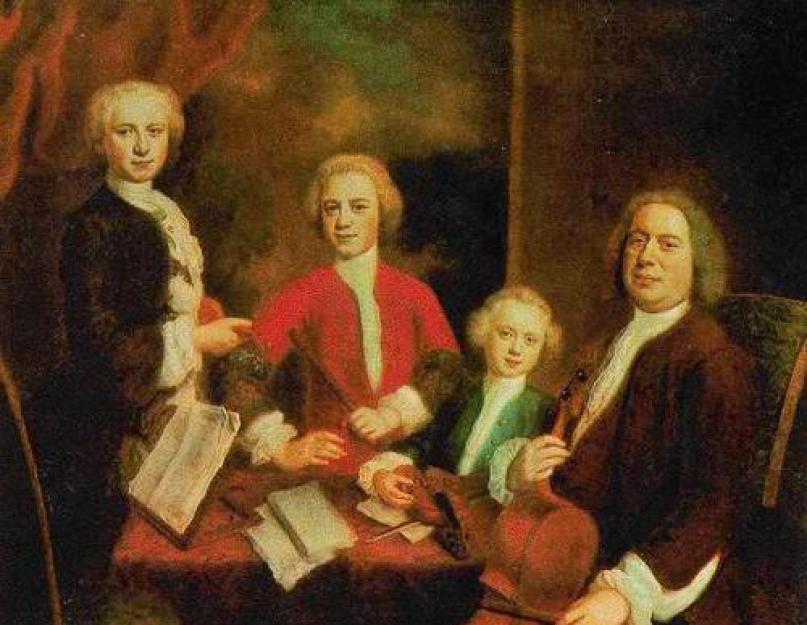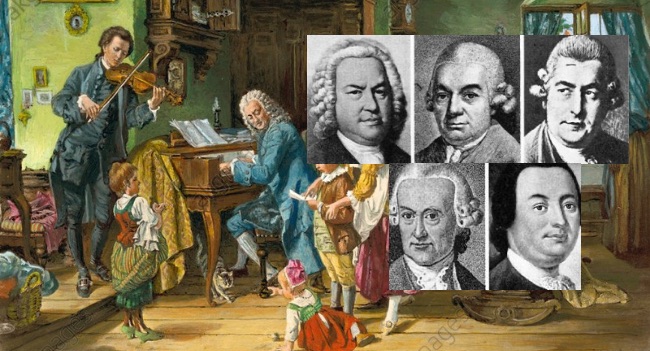Johann Sebastian Bach (1685–1750) wrote more than a thousand musical works, and had twenty children. Four of his six sons became respected composers in their own right. Though they had the same father, the two eldest—Wilhelm Friedemann (1710–1784) and Carl Philipp Emanuel (1714–1788) had a different mother, Maria Barbara (1684–1720), than the two younger sons—Johann Christoph Friedrich (1732–1795) and Johann Christian (1735–1782), who were born to Anna Magdalena (1701–1760). Indeed, the two pairs of half brothers belong to different generations, and this is apparent in the four works on the concert tonight.

Friedemann’s first job was as organist at St. Sophia’s Church, Dresden; his father wrote the letter of application for him in 1733. W.F. might have exceeded his father as an organist, and in 1746 he was hired as organist of the Liebfrauenkirche (Our Lady Church) in Halle. He eventually became music director and wrote several church cantatas in the 1750s. The cantata Erzittert und Fallet (Tremble and Falter) dates from this period and was first performed on Easter Sunday. The seven movements unfold in an arrangement much like many of his father’s cantatas for Leipzig in the 1720s and 1730s, closing with a four-part harmonization of a chorale. The opening chorus sets a festive mood with two trumpets and timpani plus strings. The voices enter before the instruments, imitative entries of the “roaring crowds” to celebrate the risen Savior. The first aria for tenor, two flutes (suggesting the “reizend sanfte Blicke”), and basso continuo shows Friedemann in his original, mannered voice. Following a recitative for tenor and soprano, the duet for soprano and bass with oboe recalls the two allegorical duets between Jesus and the Soul in Wachet auf, ruft uns die Stimme (BWV 140), though in W.F.’s cantata you could easily imagine the shepherd (Hirte) as a secular figure in a pastoral cantata. After another simple recitative for soprano and alto, the aria for soprano and two violins is full of imagery of natural disaster: floods, thunderous lightnings, and terrifying flames (Fluten, donnernd Blitzen, Schreckensflammen). Clearly, the poetry inspired Friedemann to set the text vividly.
Unfortunately, much of his music is either lost or perhaps was never written down. In 1764 he abruptly resigned his position in Halle and was unable to secure another one, though he did receive support from Princess Amalia of Prussia in his later years. Johann Nikolaus Forkel, J.S. Bach’s first biographer, wrote that W.F. “approached the nearest to his father in the originality of all his thoughts. All his melodies have a different turn from those of other composers, and yet they are not only extremely natural, but, at the same time, uncommonly fine and elegant.”
Emanuel spent a few years at the university in Frankfurt an der Oder before joining the musical entourage of Friedrich II and spent almost thirty years in his service. C.P.E.’s Magnificat (Wq 215) exists in two distinct versions. It was originally completed in Potsdam in 1749, and was likely performed in Leipzig as a tryout piece to replace his father as Cantor there. At least one account claims that J.S. Bach heard it before his death in July 1750. In any event, C.P.E. Bach eventually succeeded his godfather Georg Philipp Telemann as music director of the Hamburg municipal churches in 1768. Having no need for a Latin Magnificat in Hamburg, Emanuel adapted most of the movements in his church cantatas, with parody (German) texts, including his Passion Cantata (Wq 233), a work that was performed each Lent in Hamburg. Thus when he decided to perform the Magnificat on a concert in 1779, he felt compelled to write a new chorus no. 4, the “Et misericordia eius” to replace the original setting that was now more familiar as chorus no. 2, “Fürwahr, er trug unsere Krankheit” in his Passion Cantata. This new chorus, written thirty years later, is a good example of the “empfinsamer Stil” (sensitive style), full of refined, expressive chromatic harmony. In 1779 he also took the opportunity to add three trumpets and timpani to the opening and closing choruses and aria no. 5, plus two horns to aria no. 3 and duet no. 6.
C.P.E.’s setting of the Magnificat is partly modeled on his father’s setting (BWV 243) also in D major, which the son might have sung in the Thomas choir in Leipzig. But there are also substantial differences. J.S. divides the text into twelve distinct movements, while C.P.E. has only nine. J.S. brings back the opening music only at the end of the doxology (“Sicut erat in principio” = as it was in the beginning), but C.P.E. uses the opening music for the “Gloria Patria” and then writes a massive double fugue for the “Sicut erat in principio” that he extends and embellishes for the concluding “Amen.” (By contrast, J.S. Bach’s “Amen” is only two short statements.) If J.S. Bach heard his son’s Magnificat, he would have been proud of the harmonic richness. C.P.E. Bach told Forkel that he had to choose a style of his own, because he could never have equaled his father’s style.
Friedrich received his musical training from his father then joined the court musical establishment of Count Wilhelm von Schaumburg-Lippe at Bückeburg in 1750 and remained there the rest of his life. (His son, Wilhelm Friedrich Ernst, studied with his uncle Christian in London from 1778 until the latter’s death, and eventually became the music director to King Friedrich Wilhelm II of Prussia.) It is perhaps no coincidence that J.C.F. published his cantata Die Amerikanerin (The American Woman) in 1776, the year the Declaration of Independence was written and signed. The poem by Heinrich Wilhelm von Gerstenberg was published in 1815 as “Lied eines Mohren” (song of a Moor) and set in the Middle East, not the American colonies, but to a north German of the late eighteenth century the two places were equally exotic.
J.C.F. set the text as a solo cantata for soprano and orchestra and called it “ein lyrisches Gemählde” (a lyric picture). The first two stanzas are treated as two
separate numbers, with the opening Andante (“Saide, komm!”), followed by an Andantino grazioso (“Schön ist mein Mädchen!”). An accompanied recitative, marked Poco allegro and full of wilderness imagery, leads directly to another aria in two parts: an Allegro (“Mein Herz fleucht ihr entgegen!”) with a concluding Larghetto grazioso (“Wie Ambraduft will ich dich, Tod”). Overall, the cantata is very much in the same vein as C.P.E. Bach’s late cantata for solo voice and keyboard, “Die Grazien” (Wq 200/20), also to a poem by Gerstenberg.
After his father died in 1750, Christian came to Berlin to live and study with C.P.E. In 1755 J.C. became the only member of his family to travel to Italy and absorb the Italian style through the tutelage of Padre Martini in Bologna. While serving as organist at the Cathedral in Milan, J.C. wrote an opera for Turin and then two for the Teatro San Carlo in Naples. Their success led to his appointment as music master to Queen Charlotte in London in 1762, and he eventually achieved commercial success in Great Britain. With Carl Friedrich Abel, Bach organized annual concert series for which he wrote orchestral and chamber music; he continued to compose operas and one oratorio for the King’s Theatre, and songs for Vauxhall Gardens; and published sets of sonatas, concertos, symphonies, and chamber music in London, Paris, and Amsterdam.
His Symphony in G Minor, Op. 6, no. 6 shares the same key as Haydn’s Symphony No. 39 (c. 1768) and Mozart’s Symphony No. 25 (K. 183, 1773), and likewise has many of the same “Sturm und Drang” elements. This is Bach‘s only known symphony in a minor key, and the outer movements are in G minor, and the Andante più tosto adagio is in C minor. But it is not the minor key alone that creates the “storm and stress,” rather the angular melodies and the driving rhythms, the sudden contrasts between dynamics, and the contrasting themes: agitated one moment, full of sentimentality the next.
It is unlikely that Haydn or Mozart knew any of the pieces on the program, but at least two of the sons of Bach, C.P.E. and J.C., had a significant impact on their musical development.
Paul Corneilson is managing editor of Carl Philipp Emanuel Bach: The Complete Works.
Wilhelm Friedemann Bach
Born November 22, 1710, in Weimar, Germany
Died July 1, 1784, in Berlin, Germany
Erzittert und fallet (Oh, Tremble and Falter)
Composed in 1749–55
Performance Time: Approximately 27 minutes
Johann Christoph Friedrich Bach
Born June 21, 1732, in Leipzig, Germany
Died January 26, 1795, in Bückeburg, Germany
Die Amerikanerin (The American)
Composed 1776
Performance Time: Approximately 9 minutes
Johann Christian Bach
Born September 5, 1735, in Leipzig, Germany
Died January 1, 1782, in London, United Kingdom
Symphony in G minor, Op. 6, No. 6
Composed in the late 1760s
Performance Time: Approximately 15 minutes.
Carl Philipp Emanuel Bach
Born March 8, 1714, in Weimar, Germany
Died December 14, 1788, in Hamburg, Germany
Magnificat in D major, Wq 215, H. 772
Composed 1749
Premiered in Potsdam, Germany
Performance Time: Approximately 41 minutes.
